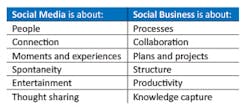Manufacturers Need to Get Serious About Social Business
Social media is a loaded term that means different things to different people. For most people, Facebook and Twitter are what spring to mind, along with images of party photos and 140-character musings. But, social media goes much further than vehicles for socializing. The lines between emerging social platforms and ones that have become so firmly entrenched that they are now thought of as “traditional” (e.g., email, instant messaging) are blurring, expanding, and continually changing.
This evolution has brought the understanding of social media conversation to a decision point for businesses: What role, if any, should social media play in the way employees interact with each other in a manufacturing environment?
“Dubious” is probably the best word to describe many business executives’ reactions to this subject. Many struggle to see the value of social interaction and worry that it might actually harm the enterprise. They already find it difficult to keep employees from posting personal Facebook or Twitter updates during work hours. Why provide them with another opportunity to waste time?
It’s easy to understand why manufacturers want to approach social media with caution, but there’s considerable risk in dismissing it altogether. Misperceptions about what these technologies mean could cause manufacturers to miss out on a significant opportunity to reinvent the way their employees work together, and generate in the process potentially game-changing benefits in the process.
Getting Down to Business
First, let’s acknowledge that Facebook and Twitter can be important for connecting with customers. But these channels have little to do with the way businesses are starting to incorporate social technology into their work environments. Some concepts are the same, but the important developments are actually taking place at the point where social media and social business diverge.
Social business embeds collaboration into employees’ daily work, and altering “the way things are done.”
Social business is less about connection and more about collaboration around processes that directly impact the bottom line. Social business embeds collaboration into employees’ daily work environments, delivering capabilities so far superior to existing ways of working that they simply become “the way things are done.”
Why Social Business Matters
Many companies think they have social business covered with email and instant messaging (IM). One notable problem is the massive loss of information that accompanies these tools. They are excellent ways to expedite communication in a busy enterprise, but email and IM are ineffective for documenting that information transfer. These interactions take place outside of organizational systems, causing information to reside in silos that depend not on established processes for tracking it, but on individuals.
A second significant issue is the sheer volume of information employees face. Email—arguably the original business collaboration tool—is overwhelming everyone. McKinsey analysts report that knowledge workers typically spend 28 hours each week writing emails, searching for information, and collaborating internally1.
While the benefits of social technology may initially have been considered important but not exactly measurable, now employers are looking at social business initiatives because of their potential to drive bottom-line benefits, such as:
- Increasing Productivity: Helping people work more efficiently is one of the central promises of social business technology. Reducing email loads, putting information where people can find it easily, and allowing employees to collaborate in the context of data, conversation trails, and project plans should indeed make them more productive—and improve overall performance in the process.
- Retaining Vital Corporate Knowledge: Social business allows companies to take advantage of information that is currently lost through technologies like email and IM. This information can hold the key to uncovering game-changing opportunities.
- Attracting and Retaining Talent: Expectations for technology have changed, most markedly for employees just entering the workforce. Newer, and especially younger, employees are accustomed to similar technologies for personal use, and they expect business software to deliver the same "fun", intuitive, easy-to-use experience.
- Improving & Speeding Decision-Making: Social business technologies deliver information that aids decision-making in ways that tools like email or IM simply cannot.
Social business technology is a collaborative platform embedded in critical organizational systems, like enterprise resource planning (ERP) and supply chain management (SCM). Access to those systems is extended across the enterprise, making the platform a company’s primary vehicle for all employee interaction.
Documents, videos, photos, plans, and conversations are all captured, organized, and made searchable and auditable. Employees can share easily, find, and receive information through both automatic notifications and business intelligence that is displayed directly on desktops or mobile devices, according to their specific roles or responsibilities.
Building a Social Business Strategy
There are some factors that are critical to consider when evaluating this technology. To maximize the benefits of any social business initiative, look for technology that will allow you to:
Integrate Systems Across Your Business, Regardless of Origin
Most companies have highly complex technology landscapes, with systems and the information they store sitting in silos. Technology has evolved so that integrating systems is simple and straightforward, allowing users to connect in a way that makes them work together without being dependent on each other. An integrated system makes social business technology an especially powerful tool. Employees can get the full picture across all areas of the business, so they can zero in quickly on what matters most and stop making decisions in isolation.
Embed Social Business in Organizational Systems
The greatest benefits of social business come from making it an integral part of employees' work environments and allowing them to collaborate alongside the critical information that resides in your systems, from an unpaid invoice to a detailed product-launch plan. Collaborative tools that simply sit on top of core organizational systems are more likely to create additional information silos and duplicated effort, rather than increased productivity.
Find Information Quickly and Easily Through Powerful Enterprise Search Capabilities
As many businesses have come to realize, having more information doesn’t necessarily promote better individual performances. With the amount of data available to companies growing exponentially, the goal is shifting from gaining access to information to being able to find the right information quickly. Social business technologies must incorporate powerful, organized, and structured search capabilities to address this issue.
Deliver Information Directly—and Automatically—to Users
In addition to making it easy for users to find information, look for technology that lets information come to your employees through what is known as contextual intelligence. This technology delivers customized, pre-analyzed key performance indicators (KPIs) directly and automatically to those who need them. This capability allows decisions to be made in the context of supporting data, with employees collaborating based on up-to-the-minute information.
Tie Mobile to Social
The use of mobile technologies has exploded in the business world, with more core organizational systems being made available via mobile devices. As adoption rates continue to rise, the combination of social business and mobile technologies has the potential to be especially powerful. The ability to upload an image to a social business platform with the touch of a button via a mobile device is just one example of how these technologies can work together to deliver capabilities in a one-of-a-kind way.
Social media has altered the way generations of people interact, and its influence will undoubtedly continue to expand. While social media concepts hold great potential for manufacturers, building a successful social business strategy must consist of more than simply tacking a Facebook-like collaborative platform onto existing organizational systems.
To generate value, social technologies must integrate seamlessly with a manufacturer’s business processes, so that working within a collaborative platform is as routine as sending an email (and, eventually, replacing that routine altogether.) The results can be transformative, and the greatest benefits will come from the ability to harness corporate knowledge in ways that are not possible with the tools most manufacturers employ today.
Larry Korak is the director of Industry & Strategy for Infor’s Industrial Manufacturing business (a developer of enterprise software platforms). Connect with him at LinkedIn.
1. McKinsey Global Institute, "The Social Economy: Unlocking Value and Productivity Through Social Technologies". July 2012.

